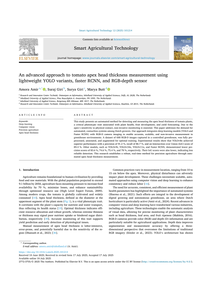No summary available
DOCUMENT
This study presents an automated method for detecting and measuring the apex head thickness of tomato plants, a critical phenotypic trait associated with plant health, fruit development, and yield forecasting. Due to the apex's sensitivity to physical contact, non-invasive monitoring is essential. This paper addresses the demand for automated, contactless systems among Dutch growers. Our approach integrates deep learning models (YOLO and Faster RCNN) with RGB-D camera imaging to enable accurate, scalable, and non-invasive measurement in greenhouse environments. A dataset of 600 RGB-D images captured in a controlled greenhouse, was fully preprocessed, annotated, and augmented for optimal training. Experimental results show that YOLOv8n achieved superior performance with a precision of 91.2 %, recall of 86.7 %, and an Intersection over Union (IoU) score of 89.4 %. Other models, such as YOLOv9t, YOLOv10n, YOLOv11n, and Faster RCNN, demonstrated lower precision scores of 83.6 %, 74.6 %, 75.4 %, and 78 %, respectively. Their IoU scores were also lower, indicating less reliable detection. This research establishes a robust, real-time method for precision agriculture through automated apex head thickness measurement.
DOCUMENT

Carnitine/choline acyltransferases play diverse roles in energy metabolism and neuronal signalling. Our knowledge of their evolutionary relationships, important for functional understanding, is incomplete. Therefore, we aimed to determine the evolutionary relationships of these eukaryotic transferases. We performed extensivephylogenetic and intron position analyses. We found that mammalian intramitochondrial CPT2 is most closely related to cytosolic yeast carnitine transferases (Sc-YAT1 and 2), whereas the other members of the family are related to intraorganellar yeast Sc-CAT2. Therefore, the cytosolically active CPT1 more closely resembles intramitochondrial ancestors than CPT2. The choline acetyltransferase is closely related to carnitine acetyltransferase and shows lower evolutionary rates than long chain acyltransferases. In the CPT1 family several duplications occurred during animal radiation, leading to the isoforms CPT1A, CPT1B and CPT1C. In addition, we found five CPT1-like genes in Caenorhabditis elegans that strongly group to the CPT1 family. The long branch leading to mammalian brain isoform CPT1C suggests that either strong positive or relaxed evolution has taken place on this node. The presented evolutionary delineation of carnitine/choline acyltransferases adds to current knowledge on their functions and provides tangible leads for further experimental research.
MULTIFILE
